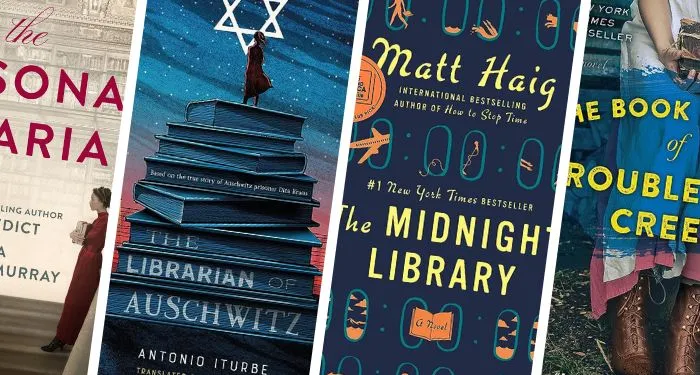
10 Awesome (and Awful) Librarians in Literature
It’s hard to find fault with librarians, those lovably nerdy folk who make a career of recommending books to readers in the community, even when they’re fictional. After all, what’s not to love about someone who passes their days in some of the only remaining quiet spaces in big cities and small towns alike, offering assistance to locate books based on even the most obscure references?
Since I am talking about fictional librarians in literature, there are some less-than-amazing ones out there. And I’m not just talking about the obnoxious, ever-shushing, puckered stereotype lurking in the darkest recesses of the social imagination, either. Despite the presence of one or two duds in the pages of all manner of novels — from historical fiction to paranormal YA — they’re worth taking a look at.
10 Awesome (and Awful) Fictional Librarians in Literature
#10: Mr. Gabriel from Michelle Knudsen’s Evil Librarian
Mr. Gabriel from Michelle Knudsen’s Evil Librarian is the absolute worst librarian on this list. He may be a hottie, but as the book’s title suggests, Mr. Gabriel is evil. Actually, if you want to be technical about it, he’s a demon. Admittedly, this devilish librarian doesn’t take center stage in Knudsen’s comedic YA read, but his mere presence is troublesome and entertaining enough that I felt I’d be remiss if I failed to include him on this list.
#9: Henry DeTamble from Audrey Niffenegger’s The Time Traveler’s Wife
Henry DeTamble is a librarian with a very unusual genetic disorder: Chrono-Impairment. In other words, he’s a time traveler, but he has little to no control over where or when he ends up. Oh, and whenever he travels through time, he ends up naked. And even though he’s in his 20s (in his life’s chronology) when he meets his future wife, Clare, she was only 6 when he met her…which is part of why Henry DeTamble ranks so low on this list: it’s just hard to get around this squidgy aspect of their relationship (as well as the fact that Clare seems to exist solely for Henry despite their temporal differences).
#8: Mrs. Elm from Matt Haig’s The Midnight Library
This gentle librarian guiding a lost soul to her path plays only a peripheral role in protagonist Nora’s life-or-death purgatory-like experience in the Midnight Library — a place where people hanging between life and death are able to drop in on all the different lives they might have led if they’d made different decisions. However, the role she does play reminds readers of the importance of librarians in a child’s life. She’s also a comforting presence and isn’t averse to challenging some of Nora’s ideas.
#7: Belle da Costa Greene (aka Belle Marion Greener) from The Personal Librarian by Marie Benedict and Victoria Christopher Murray
This historical fiction novel imagines the details of the life of the woman who curated JP Morgan’s personal collection for over 40 years. Belle da Costa Greene was a Black woman who chose to pass as white throughout her career, granting her a good deal of control over one of the wealthiest men in the U.S.’s acquisitions. So yes, this fictional character is based on a real person, but the fact that she convinced Morgan’s son to donate the collection to the New York Public Library after JP Morgan’s death meant I couldn’t leave her off this list.
#6: Oshima from Haruki Murakami’s Kafka on the Shore
Oshima helps the titular Kafka as he attempts to escape his father’s horrific prophesies. It’s because of Oshima that Kafka is able to work as an assistant at a private library and accept the gentle guidance of this kind mentor. Oshima’s own struggles stem from society’s refusal of queer and trans people, and these experiences are part of what makes this character such an effective guide for Kafka and, therefore, a strong contender on this list.
#5: Cussy Mary Carter from Kim Michele Richardson’s The Book Woman of Troublesome Creek
This novel is a work of historical fiction set in the 1930s, and Cussy Mary is a fictional character borne of the histories of the Kentucky Pack Horse Library Project and the Fugate family. I love Cussy Mary for her tenacity, big heart, and (of course) her insistence on the power of stories to expand the worlds of even the most isolated readers.
#4: Irene Winters from The Invisible Library by Genevieve Cogman
Besides having a tremendously good-looking dragon prince for an assistant (quite the job perk), Irene Winters works for a very special Library. She’s part of a large network of Librarians who are sent on missions to acquire rare books from various worlds (think: alternate realities) in order to keep reality in balance. Wily and world-hopping Irene Winters is an expert on books and diplomatic relations across magical species, and her ability to use the Language grants her access to magic that she wields to save lives (and sometimes entire worlds) in the most incredible ways.
#3 The Underground Network of Librarians in Our Missing Hearts by Celeste Ng
This close-to-home, near-future dystopia has a lot to say about censorship, racism, and blind patriotism. The U.S. has become a society characterized by anti-Asian hate codified into law by a bill called “Preserving American Culture and Traditions” (or PACT), and one terrible result is children of supposed dissidents being ripped from their families. In the face of the mass severing of familial bonds, an underground network of librarians work at great personal risk to do what they can to pass along information about children to their worried parents or, in very rare instances, reconnect these children with their parents.
#2: Sayuri Komachi from What You Are Looking For Is in the Library by Michiko Aoyama
Sayuri is a librarian who helps people find what’s missing in their lives. While she’s not the main character in the novel, her presence shapes the entire narrative because each vignette-like chapter features a character who has lost their way and is in need of guidance. Aoyama’s mysterious librarian prints them a list of recommended books, always including one additional and highly unusual recommendation that alters the trajectory of the characters’ lives in significant ways (always for the better). Not only does this librarian help her clientele find what they’re really looking for in life, but she also happens to be big into needle felting. That means that along with the list of recommended readings comes a bonus felted gift hand-made by Sayuri Komachi.
#1: Dita Kraus from Antonio Iturbe’s The Librarian of Auschwitz
This YA novel is a work of historical fiction, so yes, it’s based on the true story of a young woman named Dita Kraus, who was incarcerated at Auschwitz during WWII and served as a librarian of sorts while there. She was only 13 when she took on this responsibility, and if ensuring the distribution of books to children in a situation where such actions are likely to be punished with violence or death isn’t heroic, I don’t know what is. (If you’re wondering about how much of Dita’s story is fictionalized, check out this post by New York Public Library’s Jennifer Allen-Williams.)
Eager to Read More About Librarians and Libraries?
If you enjoyed this list of fictional librarians in literature, take a peek at this post featuring the best librarian characters in TV and film or this essay about the most memorable libraries in fiction.

















